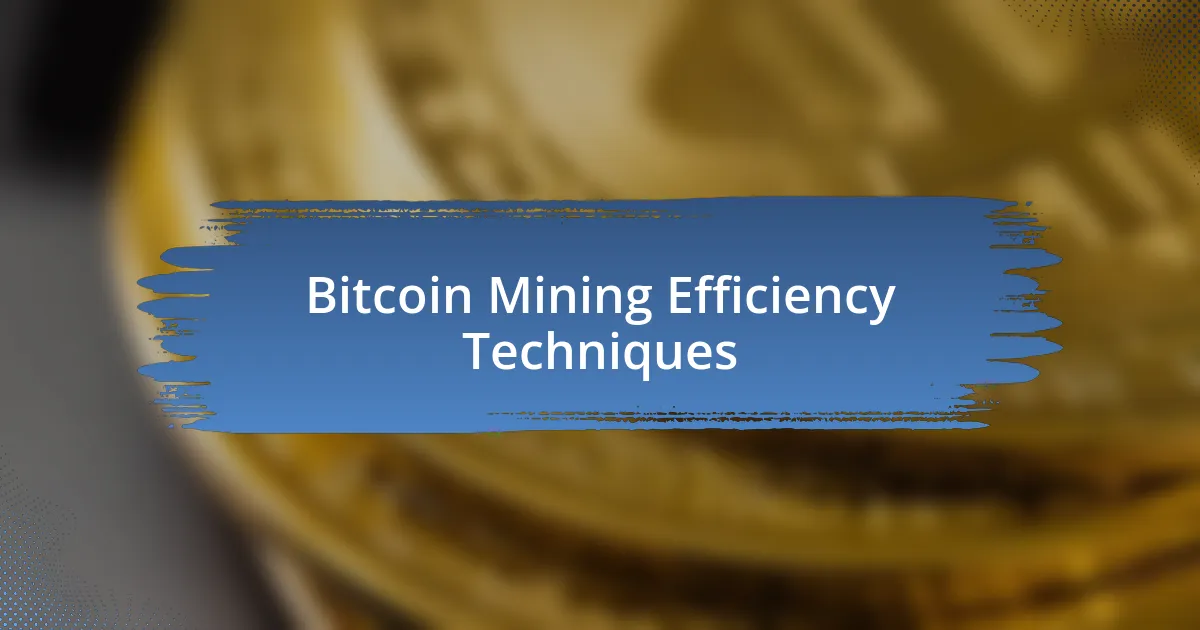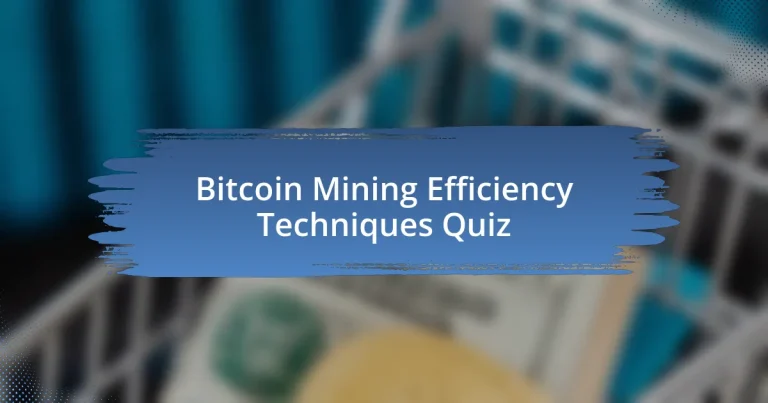
Start of Bitcoin Mining Efficiency Techniques Quiz
1. What is one of the most important factors in speeding up your bitcoin mining process?
- Increasing power supply.
- Using older software versions.
- Selecting the right hardware.
- Choosing a slower internet connection.
2. What type of hardware is specifically designed for Bitcoin mining?
- Graphics processing units (GPUs).
- Application-specific integrated circuits (ASICs).
- General-purpose processors (CPUs).
- FPGAs (Field-Programmable Gate Arrays).
3. How can miners optimize their hardware for better energy efficiency?
- By implementing techniques such as underclocking and undervolting.
- By exclusively using CPUs instead of GPUs or ASICs.
- By mining during peak energy hours for better performance.
- By using older hardware models that consume less power.
4. What is underclocking in the context of Bitcoin mining?
- Increasing hardware components to their maximum speed.
- Running software programs on multiple devices.
- Running hardware components at lower speeds than their maximum capability.
- Overclocking the mining equipment for better performance.
5. What is undervolting in the context of Bitcoin mining?
- Reducing the voltage supplied to the components.
- Overclocking the hardware for better performance.
- Using outdated mining software for operations.
- Increasing the frequency of the components.
6. How does joining a mining pool help in increasing mining efficiency?
- By working alone, which allows for more control over the mining process.
- By reducing the number of miners in the network to increase individual profitability.
- By pooling resources with other miners to increase the chances of solving blocks quickly and earning consistent rewards.
- By focusing solely on mining with high energy consumption equipment.
7. What are some energy-efficient hardware components used in Bitcoin mining?
- Standard laptops used for everyday tasks.
- General-purpose CPUs for computing tasks.
- ASICs specifically designed for Bitcoin mining.
- High-performance gaming GPUs for rendering graphics.
8. How can miners reduce energy consumption without significantly impacting performance?
- By increasing the power supply to all components.
- By mining at higher voltages to boost performance.
- By using outdated mining software for maximum output.
- By using more energy-efficient hardware components and implementing techniques like underclocking and undervolting.
9. What is the significance of choosing a mining pool with a focus on energy efficiency?
- It maximizes profit from Bitcoin mining.
- It increases the chances of solving blocks quickly.
- It allows miners to work alone without partners.
- It significantly reduces the overall energy consumption of Bitcoin mining.
10. How can miners make their mining operation more sustainable and efficient?
- By exclusively using older mining hardware for cost reduction.
- By increasing mining difficulty to improve energy consumption.
- By using renewable energy sources and implementing heat recovery systems to utilize the heat generated by miners.
- By mining in areas with the highest energy tariffs.
11. What is heat recovery in the context of Bitcoin mining?
- Capturing the heat produced by miners and using it to heat homes or other spaces.
- Generating additional energy from the heat created by mining activities.
- Discarding the heat generated by miners without utilizing it.
- Increasing the temperature of mining hardware to boost performance.
12. What are some heat recovery systems available for Bitcoin mining?
- Solar panels and turbines.
- Water purifiers and filters.
- Heat exchangers and heat pumps.
- Air conditioners and refrigerators.
13. How does the transition from CPUs to ASICs affect energy efficiency in Bitcoin mining?
- The transition has no impact on energy consumption.
- The transition stops energy use completely.
- The transition from CPUs to ASICs significantly reduces energy consumption by 5000x.
- The transition increases energy consumption by 5000x.
14. What is the current state of silicon manufacturing in Bitcoin mining?
- Relying on outdated 14nm technology with no advancements planned.
- Utilizing cutting-edge 4nm technology, with 3nm developments on the horizon.
- Focusing exclusively on 7nm technology with no future innovations expected.
- Solely using 10nm chips for all mining operations without upgrades.
15. What are some advanced techniques being explored for enhancing Bitcoin mining efficiency?
- Increasing power supply voltage to maximize performance.
- Using traditional CPUs and GPUs for mining efficiency.
- Relying exclusively on renewable energy sources without hardware optimization.
- Radio frequency (RF) and microwave design, including distributed circuit design.
16. How does full-custom design contribute to energy efficiency in Bitcoin mining?
- It involves working at the transistor level with voltages and currents instead of at the logical level with zeros and ones.
- It enhances performance by utilizing outdated hardware systems.
- It relies on software optimizations without hardware modifications.
- It focuses solely on increasing the clock speed of mining hardware.
17. What is the main type of power consumption being focused on to enhance Bitcoin mining efficiency?
- Improving both dynamic and static power consumption.
- Enhancing only static power consumption.
- Reducing hardware malfunction power.
- Focusing solely on dynamic energy usage.
18. How often can we expect a new block to be found by miners?
- Every week.
- Every hour.
- On average, every 10 minutes.
- Every day.
19. What is Bitcoin Pizza Day?
- A day when all bitcoins were mined.
- May 22nd, the day when the first real-world transaction using Bitcoin took place.
- A celebration of Bitcoin`s creation in 2009.
- The anniversary of Bitcoin`s price reaching $1000.
20. What is the significance of staying informed about the latest developments in the Bitcoin mining industry?
- It helps miners hide their identities from regulators.
- It allows miners to increase their hardware prices.
- It provides miners with free bitcoin every day.
- It helps miners adapt their strategies to stay competitive and continue earning bitcoin rewards.
21. How can miners optimize their mining software for better efficiency?
- By selecting older versions of mining software for compatibility.
- By randomly changing hardware components between sessions.
- By using the latest version of their mining software and adjusting settings such as mining intensity and overclocking.
- By only focusing on aesthetics of the mining setup.
22. What is the role of mining pools in energy efficiency?
- Mining pools eliminate the need for energy management in mining operations.
- Mining pools increase individual energy consumption by centralizing resources.
- Mining pools only focus on maximizing profit without regard for energy use.
- Mining pools share energy consumption among members, making it easier to manage and reduce overall energy usage.
23. How does the use of specialized hardware contribute to high energy consumption in Bitcoin mining?
- The use of ASICs, which are highly specialized for Bitcoin mining, still consumes a considerable amount of energy.
- The use of standard CPUs, which require less power than ASICs, is more efficient.
- The use of repurposed gaming GPUs significantly reduces energy consumption.
- The use of outdated hardware has no impact on energy consumption in mining.
24. What is the impact of increasing mining difficulty on energy consumption?
- As mining difficulty increases, so does the energy consumption of ASICs.
- Energy consumption decreases as difficulty increases.
- Mining difficulty has no impact on energy consumption.
- Energy consumption remains constant regardless of mining difficulty.
25. How can miners reduce their environmental impact?
- By using traditional fossil fuels for energy.
- By using renewable energy sources and implementing sustainable practices like heat recovery.
- By increasing the number of mining rigs in use.
- By mining in urban areas to utilize waste heat.
26. What is the significance of reducing energy consumption in Bitcoin mining?
- It reduces operating costs and makes it easier for small-scale miners to compete with larger operations.
- It helps in generating more Bitcoin blocks to improve market value.
- It increases transaction speeds and enhances security measures.
- It eliminates the need for mining pools and independent miners.
27. How does the evolution of mining technology impact efficiency?
- The transition from CPUs to GPUs to ASICs has significantly improved mining efficiency over the years.
- Shifting to manual mining techniques greatly increases efficiency.
- Using traditional mining methods has no impact on efficiency.
- Relying only on outdated technology enhances mining efficiency.
28. What are some real-world examples of energy-efficient Bitcoin mining?
- Centralized Mining Operations, focusing on maximizing profits at high energy costs.
- Minerset Georgia site, which implements various energy-efficient practices.
- Financial Blockchain Institute, which conducts research on blockchain technology.
- Conventional Mining Farms, which rely on outdated hardware and high energy consumption.
29. What is the concept of silent, energy-efficient Bitcoin mining?
- It means using outdated hardware to save costs during mining activities.
- It focuses solely on maximizing profit without regard for energy use.
- It requires traditional methods that produce high levels of noise and emissions.
- It involves using innovative solutions to address noise and heat issues while making the mining operation more efficient and environmentally friendly.
30. How can miners address noise issues in their mining operation?
- By increasing the number of miners to distract from the sound.
- By using louder equipment to mask the noise.
- By making the mining operation silent or significantly quieter using noise-reducing solutions.
- By relocating the mining operation to a remote area without noise concerns.

Quiz Completed: Congratulations!
You’ve successfully completed the quiz on Bitcoin Mining Efficiency Techniques! It’s great that you took the time to explore this important topic. Through this quiz, you might have learned about various strategies that miners use to optimize their operations. Understanding these techniques can provide valuable insights into the world of cryptocurrency mining.
Reflecting on your experience, you probably discovered how various technological advancements and practices can significantly enhance mining efficiency. From energy use optimization to hardware choices, each element plays a crucial role. This knowledge equips you with a deeper appreciation of the complexity and dynamism involved in Bitcoin mining.
Now that you’ve completed the quiz, we invite you to dive deeper into the topic. Check out the next section on this page regarding Bitcoin Mining Efficiency Techniques. It’s packed with information that can help you expand your understanding even further. Embrace the opportunity to learn more and enhance your knowledge in this fascinating field!

Bitcoin Mining Efficiency Techniques
Understanding Bitcoin Mining Efficiency
Bitcoin mining efficiency refers to the effectiveness of mining operations in converting computational power into mined Bitcoin. This is typically measured in terms of hashes per second per unit of electricity consumed, often expressed in joules per gigahash (J/Gh). Efficient mining reduces operational costs and increases profitability. The increasing complexity of Bitcoin’s proof-of-work algorithm necessitates advanced techniques and better hardware to maintain high efficiency levels.
Hardware Optimization Techniques
Hardware optimization in Bitcoin mining involves selecting and configuring mining devices for maximum performance. The use of specialized hardware, such as ASIC miners, significantly enhances efficiency compared to general-purpose systems. Advanced miners often have better cooling mechanisms and power supply units to ensure stable operation, a crucial factor in achieving optimal hashing rates. Upgrading components like cooling fans and power supplies can lead to lower electricity consumption and improved performance.
Energy Consumption Management
Managing energy consumption is key to enhancing Bitcoin mining efficiency. This includes monitoring electricity usage and optimizing power sourcing. Miners often seek access to cheaper, renewable energy sources, such as hydroelectric or solar power. Using energy management systems allows for real-time tracking and decision-making, leading to strategic operations during off-peak electricity rates. Effective management reduces operational costs and can significantly impact profitability over time.
Mining Pool Strategies
Participating in mining pools is a common strategy to improve efficiency. Mining pools allow miners to combine their computational power to increase the overall chances of solving blocks. By joining a pool, individual miners receive a proportional share of the rewards, smoothing out income fluctuations. The collective effort often results in more consistent payouts and reduces the variance associated with solo mining. This approach maximizes the efficient use of mining resources.
Software Optimization and Code Efficiency
Software optimization plays a crucial role in Bitcoin mining efficiency. Efficient mining software can enhance performance through better resource management and optimization algorithms. Miners utilize software that maximizes the hardware capabilities, ensuring that hashing power is not wasted. Regular updates and fine-tuning of software settings can lead to improvements in mining efficiency. Advanced options, such as overclocking settings and optimized mining configurations, further enhance outputs while maintaining stability.
What are Bitcoin Mining Efficiency Techniques?
Bitcoin mining efficiency techniques are methods used to maximize the output of miners while minimizing the input costs associated with electricity, hardware, and other resources. These techniques include the use of more efficient hardware like ASIC miners, optimizing cooling systems to reduce overheating, and utilizing renewable energy sources to lower electricity expenses. For example, ASIC miners can achieve hash rates exceeding 100 TH/s, significantly outperforming older hardware.
How can miners improve efficiency in Bitcoin mining?
Miners can improve efficiency by adopting advanced mining hardware, optimizing operational processes, and using energy-efficient cooling solutions. They can also switch to locations with cheaper electricity or renewable energy sources, which reduce operational costs. Studies show that miners utilizing renewable energy can cut costs by up to 60%, leading to greater profit margins.
Where can miners find cheap energy for Bitcoin mining?
Miners can find cheap energy in regions with abundant natural resources, such as hydroelectric power in mountainous areas or areas with significant wind and solar energy potential. For instance, countries like Iceland and Canada offer low-cost electricity due to their vast renewable energy sources. It is documented that in some areas, energy costs can be as low as $0.02 per kilowatt-hour.
When is the best time to mine Bitcoin for efficiency?
The best time to mine Bitcoin for efficiency is during periods of low energy demand when electricity prices are lower, often during off-peak hours. Additionally, miners should focus on times when Bitcoin’s market price is stable or rising to maximize potential profits. Research indicates that mining profitability can fluctuate based on both energy prices and Bitcoin’s market price, making strategic timing crucial.
Who benefits from Bitcoin mining efficiency techniques?
Bitcoin miners, investors, and the overall cryptocurrency ecosystem benefit from mining efficiency techniques. Miners gain higher profits and lower costs, while investors see potential returns on investment from more sustainable practices. Improved efficiency can also enhance network security and stability, contributing positively to the entire Bitcoin network. For instance, efficient mining operations can increase hash rates, which directly strengthens the network’s resilience against attacks.


